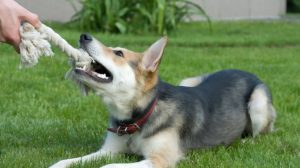The Wolfspitz is a lovable, affectionate, and self-confident dog with many other positive characteristics. You should pay special attention to the training of the Wolfspitz so that your tuft of fur develops into a happy and well-balanced dog.

The history of the Wolfsspitz’ or Keeshond goes back a long way. As early as the Middle Ages, the alert and robust dog was kept as a yard and guard dog. Today it is trendy in France and Great Britain – but the dog breed with the bushy coat also delights many dog lovers in Germany.
Wolfspitz training: Patience and respect are required
A wolf spitz has a mind of its own, so you need to be patient with it. However, you will have particular pleasure in training the Wolfsspitz, as the breed is intelligent and, depending on the disposition, also eager to learn. Use motivation and praise in dog training and education about play and fun.
It would help if you refrained from violent subordination exercises or the like – the Wolfspitz generally does not think much of apparent subordination. If a Wolfspitz feels under pressure, it relies more on the means of ignoring instead of fighting open power struggles – therefore, patience and tact are the be-all and end-all when dealing with the great ball of fur. As with all other animals, always treat your Spitz with respect and ideally use positive reinforcement.
Training with the Wolfspitz
As I said, lace tends to have minds of its own. At the same time, they make exercises and training sessions a lot of fun. However, what a Wolfspitz likes is decided by him and not by the owner. In any case, you should encourage and challenge your Wolfspitz both physically and mentally. The breed likes challenges. For example, try a search and snoop games. Dog sport is also a popular activity. Tip: Use the target stick or a clicker for variety and extension of the training. You can find more information on this in the guide: “Clicker training with dogs: what is that anyway?”
Dogs love to exercise outdoors. Exploratory walks in interesting terrain or varied training in the open field ensure that the fur noses are in a good mood. By the way: Hunting games are not suitable for the Spitz because the dog does not have a strong hunting instinct.
Dealing with Wolfspitz: Examples
Here you will find a few tips on which dog sport and training you can keep your Wolfspitz wonderfully busy:
● Agility Training: Agility is an excellent occupation for the Wolfspitz. The action-packed dog sport is physically and mentally demanding and puts your cold nose to good use. Find out about agility courses in your area and master poles, tunnels, hoops, and slaloms with your Spitz. In the guide, you can find more about agility: “Agility training for dogs: what is that?”
● Tricks: Many people are familiar with the Spitz as a circus dog. Since the dogs love to learn tricks and are sometimes highly skillful, try it and start small. Walking on the hind legs, jumping through hoops, and other tricks are usually known quickly. However, always be patient when teaching your Spitz tricks. Inexperienced hobby trainers can find help with courses at the dog school or with the dog trainer.
● Nosework: Nosework is a lot of fun for most representatives of the dog breed. You can find more about nose work in the guide: “Nose work with the dog: what is that?”
● Mantrailing: A wolf spitz is a very human-related and affectionate representative – ideal conditions for mantrailing or the search for people. The simple variant can be that a family member is hiding somewhere; the Spitz has to wait and then goes on a quest. Caution: Only play this game to the extent that the separation does not stress your dog.
● Swimming: Some Spitz are real water rats – try out whether your four-legged friend is one of them and go swimming with them.
● Retrieve: Sure, a Spitz is not a retriever – they lack the hunting instinct in comparison; nevertheless, some specimens enjoy retrieving. Just try it with a ball or frisbee.








